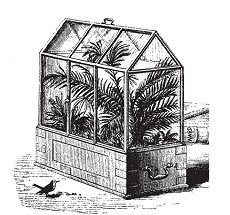Terrarium
Terrariums are enclosed environments for growing and displaying plants. They can range from simple containers housing small plant species to elaborate mini-ecosystems showcasing a diverse array of flora. Terrariums are not only a means to bring a piece of nature indoors but also serve as educational tools, demonstrating the principles of the water cycle, photosynthesis, and ecosystem sustainability.
History[edit | edit source]
The concept of the terrarium was first developed in the early 19th century by Nathaniel Bagshaw Ward, a London doctor with a passion for botany. Ward discovered the terrarium principle by accident when he observed a fern and grass growing in a sealed bottle, despite neglect. This led to the invention of the Wardian case, which revolutionized the transport of plants across the globe, particularly in the British Empire, by protecting them from salt air and temperature fluctuations during long voyages.
Types of Terrariums[edit | edit source]
Terrariums can be broadly classified into two types based on their moisture environment: closed terrariums and open terrariums.
Closed Terrariums[edit | edit source]
Closed terrariums are completely or partially sealed environments that create a high humidity atmosphere conducive to moisture-loving plants, such as ferns, mosses, and orchids. The sealed container of a closed terrarium creates a miniature water cycle, with water condensing on the walls of the container and trickling back to the soil, minimizing the need for watering.
Open Terrariums[edit | edit source]
Open terrariums, on the other hand, are not sealed and are suitable for plants that prefer a dry environment, such as succulents and cacti. These terrariums require more frequent watering than closed terrariums but allow for greater airflow and are less prone to issues like mold growth.
Creating a Terrarium[edit | edit source]
Building a terrarium involves several steps, starting with selecting a clear, transparent container, which can range from a simple glass jar to a sophisticated glass case. The basic layers in a terrarium include:
- Drainage Layer: A layer of small stones or gravel at the bottom to prevent water from pooling around the plant roots.
- Charcoal Layer: A thin layer of activated charcoal to keep the water fresh and prevent mold and bacteria growth.
- Soil Layer: A layer of soil appropriate for the types of plants being used.
- Plant Layer: The plants themselves, chosen based on the terrarium type (closed or open).
- Decoration: Optional decorative elements like pebbles, figurines, or wood can be added for aesthetic purposes.
Care and Maintenance[edit | edit source]
The care for a terrarium varies depending on its type. Closed terrariums generally require less frequent watering due to their self-sustaining environment. It's crucial to monitor the moisture levels and open the container occasionally to prevent over-condensation and mold growth. Open terrariums, being more exposed, need more regular watering and maintenance. Both types benefit from indirect light, as direct sunlight can cause overheating and harm the plants.
Educational and Decorative Uses[edit | edit source]
Terrariums are popular not only for their decorative appeal but also for their educational value. They can be used to teach concepts of ecology, biology, and environmental science, making them valuable tools in classrooms. Additionally, they offer a way to engage with gardening in limited spaces, such as apartments or offices.

This hobby-related article is a stub. You can help WikiMD by expanding it.
Search WikiMD
Ad.Tired of being Overweight? Try W8MD's physician weight loss program.
Semaglutide (Ozempic / Wegovy and Tirzepatide (Mounjaro / Zepbound) available.
Advertise on WikiMD
|
WikiMD's Wellness Encyclopedia |
| Let Food Be Thy Medicine Medicine Thy Food - Hippocrates |
Translate this page: - East Asian
中文,
日本,
한국어,
South Asian
हिन्दी,
தமிழ்,
తెలుగు,
Urdu,
ಕನ್ನಡ,
Southeast Asian
Indonesian,
Vietnamese,
Thai,
မြန်မာဘာသာ,
বাংলা
European
español,
Deutsch,
français,
Greek,
português do Brasil,
polski,
română,
русский,
Nederlands,
norsk,
svenska,
suomi,
Italian
Middle Eastern & African
عربى,
Turkish,
Persian,
Hebrew,
Afrikaans,
isiZulu,
Kiswahili,
Other
Bulgarian,
Hungarian,
Czech,
Swedish,
മലയാളം,
मराठी,
ਪੰਜਾਬੀ,
ગુજરાતી,
Portuguese,
Ukrainian
Medical Disclaimer: WikiMD is not a substitute for professional medical advice. The information on WikiMD is provided as an information resource only, may be incorrect, outdated or misleading, and is not to be used or relied on for any diagnostic or treatment purposes. Please consult your health care provider before making any healthcare decisions or for guidance about a specific medical condition. WikiMD expressly disclaims responsibility, and shall have no liability, for any damages, loss, injury, or liability whatsoever suffered as a result of your reliance on the information contained in this site. By visiting this site you agree to the foregoing terms and conditions, which may from time to time be changed or supplemented by WikiMD. If you do not agree to the foregoing terms and conditions, you should not enter or use this site. See full disclaimer.
Credits:Most images are courtesy of Wikimedia commons, and templates, categories Wikipedia, licensed under CC BY SA or similar.
Contributors: Prab R. Tumpati, MD





